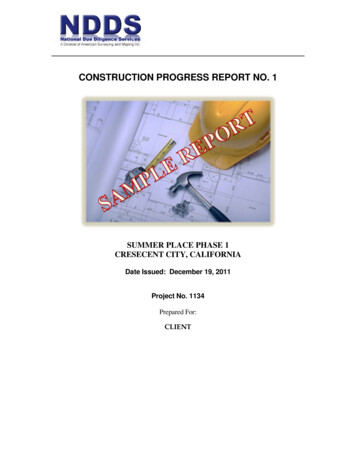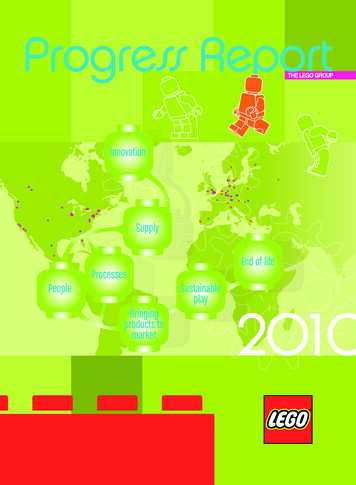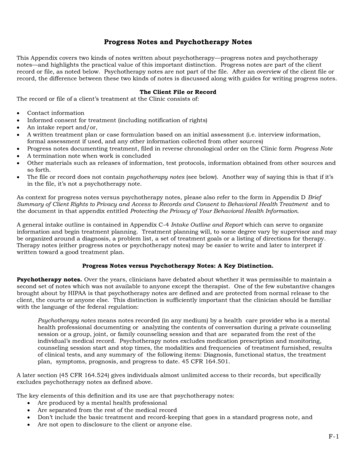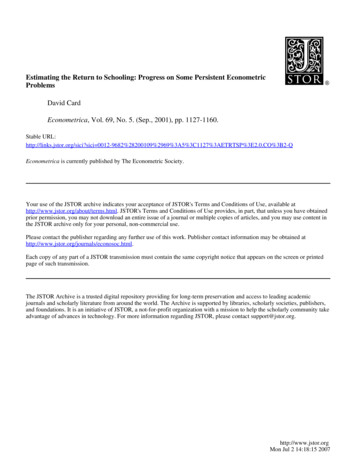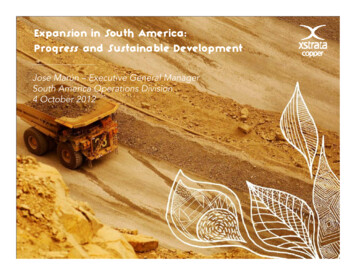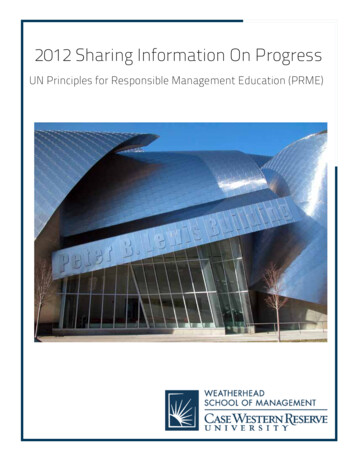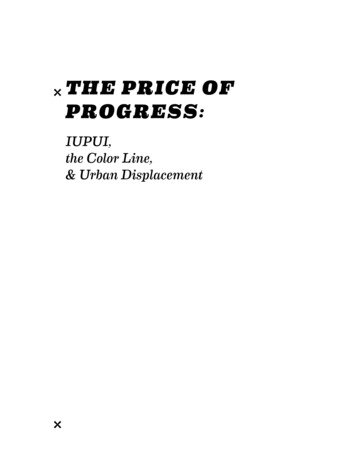
Transcription
THE PRICE OFPROGRE SS:IUPUI,the Color Line,& Urban Displacement
THE PRICE OF PROGRE SS:IUPUI, the Color Line, & Urban DisplacementThis book is a publication ofOffice of External AffairsIndiana University-Purdue University Indianapolis(I U PU I)355 N. Lansing, Suite 136Indianapolis, Indiana 46202-2896 USAhttp://www.iupui.eduCopyright 2010by Paul R. Mullins and Glenn S. WhiteAll rights reservedNo part of this book may be reproduced or utilized inany form or by an means, electronic or mechanical,including photocopying and recording, or by anyinformation storage and retrieval system, withoutpermission in writing from the publisher.Book Design by Lee Vander Kooi & Drew Hammond,Ric Sellers, Trenton Elkins, Terri Wada, andBrandon StuckPrinted in the United States of America
Table of ContentsI n d i a n a Ave nu e1.1 “A World within Itself” p. 221.2 “They Can Make It Anywhere” p. 321.3 “The Walker building was the anchor” p. 361.4 “Taken Care of by the Black Community” p. 421.5 “We Were Living Good” p. 481.6 “It was just a very, very close-knit, warm proud community” p. 561.7 “To have your children [there] was like putting themin a Private school” p. 621.8 “The first time for Blacks to purchase new homes builtfrom the ground up anywhere” p. 64
E du c at ion2.1 “A Polished Product” p. 742.2 “I Thought You Had to be a Genius” p. 82T h e C olor L i n e3.1 “There is a thing about segregation” p. 943.2 “Now, You Know that’s Not Right” p. 1083.3 “The Costs We Paid” p. 1163.4 “Somebody Probably Knew About it Downtown” p. 1223.5 “It was for Progress” p. 130
FOREWORDWRITTE N BY Charles R. Bantz, Chancellor of IUPUIPlace matters. Throughout ourlives, each person is shaped by one’sexperiences in a place. Place is wherewe as individuals come together withthe physical, cultural, and social. Ourmemories of place are intense. Evena newcomer to IUPUI like me hasintense memories of this place.I can still picture the rain stopping, feel the hot sun, experience pridein the new IUPUI Campus Apartments on the River Walk, smile at thehundreds of people celebrating the newhomes for our students—even thoughthat outdoor dedication ceremony forour new campus housing complex wasnow six years ago.IUPUI’s second cha ncel lor,Glenn W. Irwin, Jr., M.D., was a medical student here in the 1940s (M.D.,1944), became a faculty member in1950, and still comes to work. His senseof place used to be expressed in a slideshow he called “West Side Story.” Inthat, he recalled much of the campus’shistory from memory and personalexperience.This book reconstructs this senseof place, based on the memory and personal experiences of the people wholived, worked, owned businesses, andwent to school in the neighborhoodsthat were displaced by the growth ofthe IUPUI campus. Commissioned aspart of IUPUI’s 40th anniversary commemoration, these oral histories givevoice to a community long dispersedby a “1960’s urban renewal” strategythat cleared large areas in search of“progress.” It secures for them theirrightful place in our history. It preserves knowledge of the sacrifices thatpeople made—people who came awaywith mixed feelings about what happened to their lives and properties. Youwill hear it in their accounts. There isno institutional voice in these pages—just the voices of the men and women
who at one time called this place homeand these streets their neighborhood.As best as we can determine,no other urban universities haveexamined their history in quite thedeliberate way that IUPUI is doing.Thanks to the work of Professor ofAnthropology Paul R. Mullins, whoimmediately recognized the archaeological significance of the campus andits surrounding neighborhood whenhe joined our faculty in 1999, IUPUIhas worked to connect with its past.His urban archaeology program—acooperative project involving IUPUIfaculty and students, the RansomPlace Neighborhood Association, andthe Indianapolis Urban League—hasuncovered artifacts and stories thattell a history of the neighborhood. Thisproject has partnered with formerresidents who lay claim to the neighborhood’s heritage, and this book’sresearch was conducted with India-napolis native Glenn S. White. Thearchaeology and neighborhood historyproject have served to create an ongoing dialogue between the previous andcurrent occupants of this land.
PREFACETHE PRICE OF PROGRE SS: IUPUI, the ColorLine, and Urban DisplacementFrom its European settlement in the early 19th century,Indianapolis’ near-Westside was home to a wide range ofimmigrants from throughout Europe and other regions ofAmerica. These early settlers included a modest antebellum African-American community that expanded afterthe Civil War and rapidly established substantial African-American neighborhoods along many of the streetsadjoining Indiana Avenue. The African-American community grew very quickly in the early twentieth century,when the “Great Migration” attracted scores of AfricanAmericans fleeing the Jim Crow South for Northern citieslike Indianapolis. Indianapolis was not legally segregated,but in practice Indianapolis was governed by a complexsystem of unspoken racist codes that dictated the growthof the segregated African-American community in thenear-Westside.Indiana Avenue was the main corridor slicingthrough the near-Westside, and it rapidly became home tomany African-American businesses, churches, social institutions and jazz clubs. Completion of the Walker Building in1927 brought additional prominence to the area: The building housed Madam C.J. Walker’s manufacturing company,a theatre that attracted national artists and performers,and office spaces for Black professionals and entrepreneurs.The near-Westside became “the” place for Blacks to pursue
and create their segregated slice of the American Dream over morethan 50 years.After World War II, much of urban America was transformedby a series of federal, state, and local initiatives referred to collectivelyas “urban renewal.” What this meant in practice was enacted quitedifferently in various communities over a half century, but urbanrenewal legislation almost always targeted African-American communities like the one in Indianapolis’ near-Westside. Some legislationwas aimed to erase urban “blight,” and there certainly were very challenging conditions in many cities. However, many wholesale removalsalso erased thriving African-American communities that were definitely not “slums.” In some cities removals secured property for theexpansion of state and local governments; in others it secured land forinterstate expansion; and in some it broke up powerful African-American voting blocks: All of those things happened in Indianapolis, andthe social, psychological, and material repercussions of widespreadracial marginalization and displacement remain an unaddressed andraw legacy in many communities, including Indianapolis.This book is a written compilation of elders’ memories thatfocuses on the central features of life in the community along andacross the color line, ranging from faith to schooling to leisure andentrepreneurship. The book hopes to encourage public reflection onconcerns that have circulated throughout the African Americancommunity for many years: That is, what were the concrete social,material, and personal prices of the displacement of a once-vibrant,African American community that resulted in the establishmentof IUPUI? This book is not a standard linear history that aspires toestablish one conclusive interpretation for African-American heritageand experience in the near-Westside. Instead, it is taken from 29 oralhistorical interviews conducted with a range of African Americanswho lived, worked, worshipped, shopped, and/or were educated in thenear-Westside. We have chosen excerpts from those interviews; but,
as much as possible, we hope the voice of elders’ experiences shapeshow the near-Westside and its ultimate demise are presented in thisbook. The interviews were predominately focused on life since the1920s, and we systematically discussed life on the Avenue, the socialand material realities of life along the color line, and the widespreaddisplacement that occurred in the community from the 1950s onward.It reflects residents’ sentiments about the community’s displacementafter World War II and leading to the development and establishmentof IUPUI.Such displacements occurred throughout the United States,removing marginalized and often-Black communities for new university campuses, but virtually no urban universities have reflectivelycontemplated their own roles in these dramatic transformations. Ourgoal is to encourage a public discussion on the legacy of urban displacement and to acknowledge the University’s role, recognize the pricespaid for the establishment of a world-class university, and ultimatelywork towards respecting the rich legacy of this community and thethousands of people who lived and thrived in the near-Westside. Thisconversation--along with publication of the compiled memories--canbe the beginning of a critical and reflective public discourse in whichIUPUI can publicly examine its institutional complicity in urbanrenewal without ignoring the dramatic and life-changing public benefits the University brings to the city and its residents.We want to thank the many people who contributed to this project. First and foremost, this includes the many elders who graciouslyagreed to be interviewed and routinely talked to us many hours longbeyond the single hour they were being recorded. We are humbledto have been trusted with their words and hope this book begins toreflect the richness of their experiences. This project was fortunateto have the support of IUPUI Vice Chancellor for External AffairsAmy Warner. Amy instantly embraced the proposal to produce a history that was told in the words of community elders and confronted
challenging dimensions of IUPUI’s history at the very moment theUniversity is celebrating its 40th Anniversary. The project has beenthoughtfully shepherded throughout its production by Suzanne Vick,IUPUI Director of Strategic Partnerships and Promotions. Lee VanderKooi and his students Drew Hammond, Ric Sellers, Trenton Elkins,Terri Wada, and Brandon Stuck produced a beautiful book from oralhistorical excerpts and scattered photographs and were essential tosuccessfully framing the book’s message. Thanks to Gwendolyn Crenshaw, Theresa L. Roberts, and Wilma Moore Gibbs for their informedconsultation and support. Many more family members, communitymembers, and friends whose words do not appear here have discussedthis project with us over nearly two years, and all of them were absolutely essential to this book. Any errors of fact or interpretation arefully our responsibility.
1n
1 INDIANA AVE.Indiana Avenue was one of thefour diagonal thoroughfares in the1821 plat of Indianapolis, and by thefinal quarter of the 19th century aboutone-third of the city’s African-American residents lived in the neighborhoods adjoining “the Avenue.” In thefirst decade of the 20th century a waveof African Americans came to Indianapolis from the South in the GreatMigration, and many of these arrivalssettled in the near-Westside aroundthe Avenue. The Avenue very rapidlybecame the heart of Indianapolis’ African-American community. Businesses,entertainment venues, professionaloffices, and many other African-American enterprises could be found somewhere along the Avenue for more thana half-century. African-American residential neighborhoods including cornerstores, churches, and schools fanned offthe Avenue in all directions, and thehomes included modest cottages andspacious residences alike. The IndianaAvenue area remained a vibrant African-American business district, socialhub, and neighborhood into the 1950sand 1960s. Its significance and importance was tempered by factors farbeyond the control of its inhabitants.
1 . 1 “A Wo rld wi thi n Its el f ” p. 2 21 . 2 “ They Ca n Ma ke It Anywhe re” p. 3 21 .3 “ The Walke r bu ild i ng wa s the a nch o r” p. 361 . 4 “ Ta ke n Ca re of by the B la ck Co m mu ni ty” p. 4 21 .5 “ We We re L ivi ng Good” p. 4 81 .6 “ It wa s ju s t a ve ry, ve ry cl os e - k ni t , wa rm p ro u d co m mu ni ty” p. 561 .7 T o ha ve yo u r child re n [the re] wa s l ike pu tti ng the mi n a Priva te s ch ool: f la n ne r h o u s e p. 621 .8 “ The fi rs t ti me fo r B la ck s to pu rcha s e new h o mes bu il tfro m the g ro u nd u p a nywhe re” p. 6419
The Sunset Terrace was among the best-known clubs onIndiana Avenue. Owned by brothers Denver and SeaFerguson, this crowd gathered at the club in 1949 beforea performance by Dizzy Gillespie.Figure 1
“A World within Itself”:LIFE ON THE AVENUEIndianapolis was not legally segregated, but in practice the city’s spaceswere governed by a complex systemof unspoken racist codes. An AfricanAmerican business district rapidlyemerged on the Avenue, and most ofresidents’ consumer needs, leisure, andsocial life were served by spaces alongIndiana Avenue.
Indiana Avenue was a world within itself. We had everything thatwe wanted right there on Indiana Avenue. We didn’t have to godowntown. We had various places that we were able to go - neighborhood grocery stores and that kind of thing. --- AbdullahPresident Roosevelt was elected in ’32. He took office in the first of ’33.Almost immediately prohibition ended and liquor came in. And whenthat happened, taverns and bars opened up all over the country. Indiana Avenue was the area where it happened for us. Mainly, there wereother areas in the other parts of town but that was the place to go, theAvenue. They’d say, where you going today? I’m going to the Avenue.Well, it was known that you went there for a good time. Because therewere clubs, and bars, etcetera. --- RidleyThere was the Walker Theatre, we used to go to the show there, watchfirst-run movies for nine cents and it had the best popcorn in the world.And further down west of the Walker Theatre there was a theatrecalled The Lido and the Lido was the home of cowboy hits. They hada cowboy and they had two feature movies. I don’t know how manychapter plays and they had previews of movies coming up. You couldgo in there at ten-o’clock in the morning and probably come out at fouror five o’clock in the evening. That’s how long you were there, and allalong all along Indiana Avenue all the way down to New York Streetthere were places to eat . It was just a community within a community, I mean we didn’t have to go outside that community.--- AdamsThere was a movie theater on the alley that ran down beside my houseand came on up to the Avenue. It ran between Indiana Avenue andNorth Street and at the corner of this alley and Indiana Avenue therewas this movie theater. Its original name was “Two Johns” because itwas owned by two men by the name of John. And then it was changed23
1 later to the Lido Theater. Next door to it was a drugstore and it had acounter in there a food counter. And it had ice cream on one end andthen they served coneys and hot dogs and hamburgers on the otherend of it. A coney was only a dime and a bottle of pop was a nickel. Sowhat the heck, you get a quarter a kid could have a date. But that wasnice. They had the afternoon matinees at the Two Johns. They hadthe serials like “Tarzan and the Tiger” and that sort of thing “Riders of the Purple Sage” . You go to the movie and stay half of the daywatching it over and over again. You come out and get you a coney anda bottle of pop. That was a big thing you had a good Saturday afternoon. --- RidleyOh, we went to a show three or four times a week. Went to the WalkerTheater on Sundays, and then you went home had dinner and goback to the Lido Theater on Sunday evenings. At the Lido, they hadthe serials that they showed every Saturday and on Tuesday, I think.And so you had to go on Tuesday or Thursday to keep up with theserials and we’d go to the Y, too. But we’d go to the theater all thetime and that was mainly it because you didn’t really go too muchout of your neighborhood because you don’t want to get into anythingwith these other groups in other neighborhoods. You had guys whosort of felt like their turf was their turf, and they protected their turf.--- CummingsWell the Avenue during the days of Joe Louis they’d block off thestreets when the fight was on. Used to be another theatre on the Avenue called The Indiana. And I remember when the “Gone With TheWind” movie was made. You had to pay a bundle of money to go see it --- CoeThe Avenue was not a place that everybody longed to go to. That’s thefirst thing. People speak as if it was always as popular as it is now
that wasn’t true. Young people, like when I was in high school, werewarned against going there. I guess it started going down while I wasin the South teaching, and that would be in the 40’s. But it was thereand they were proud of it in many ways. --- A RayAs a teenager and a young person I didn’t go on the Avenue. Therewas nothing there to interest me then. When I went to the Avenue Iwas out of high school, you know. Everybody wanted to go to IndianaAvenue and the different nightclubs. This was something new, youknow . Everybody was dressed up to show their little outfit this ismostly what they went for. --- MiltonWe spent a lot of our time as I was going through school, junior andsenior high school, doing things around Indiana Avenue. The ninecent show. Going to the Walker Theatre walking from Haughvilledown Indiana Avenue on our way to downtown. We used to walkfrom Tenth . Tenth and Sheffield, to Murphy’s. And I mean, we justwalked down Indiana Avenue, straight across the bridge. --- BrownYou know what I compare Indiana Avenue with now is Broad Ripple how we would walk up and down the street and go into one littlenightclub to the other. When I go drive through Broad Ripple now Igo, “This is how we used to do on Indiana Avenue.” Just out of oneplace and into another. And then, ride the street car home, ride the bushome, because that’s what you had to ride home. --- MiltonI didn’t hang out on the Avenue . I never hung out on the Avenue,I think I’d have been disowned because I still had chores left andthings to do at home. --- J. ColemanI think that my feeling was its reputation was not good. It wasn’t goodto be on the Avenue, you know. That’s not the place you were supposed25
1 to be unless you know you wanted trouble. Or you wanted to get intosome trouble. --- J. ColemanI was in some of the clubs before I should have been. But by me being amusician, and my dad was a musician also, I just followed along withmy dad. I used to go in these clubs. I used to go down to the Sunset along time ago and especially on a Sunday when all the big names camein like Duke Ellington. All of them used to come in there and I usedto stand right there by the drummer. I wouldn’t get a seat—just standthere by the drummer all night long and watch them. And then, by meliving on the Southside of Indianapolis, the last streetcar would leavethe Circle around midnight. They stayed open until 1:00. Many timesI missed that last streetcar and I had to walk all the way to the Southside because we had no cars during those days. --- A. ColemanMy father met my mother, very ironically, interestingly, at somerestaurant on Indiana Avenue. He would frequent that restaurantand had said to his buddy that he was kind of sweet on the waitress.--- BrownYou can start from Indiana Avenue and Illinois Street all the way backto the hospital clubs, and restaurants all up and down that wholeAvenue. You could go from one club right into another club all different kinds of entertainment, you know. I know that that will neverbe anymore But, there used to be clubs all up and down the Avenue:the Cotton Club, George’s Bar, Paradise, Industr
deliberate way that IUPUI is doing. Thanks to the work of Professor of Anthropology Paul R. Mullins, who immediately recognized the archaeo-logical significance of the campus and its surrounding neighborhood when he joined our faculty in 1999, IUPUI has worked to connect with


